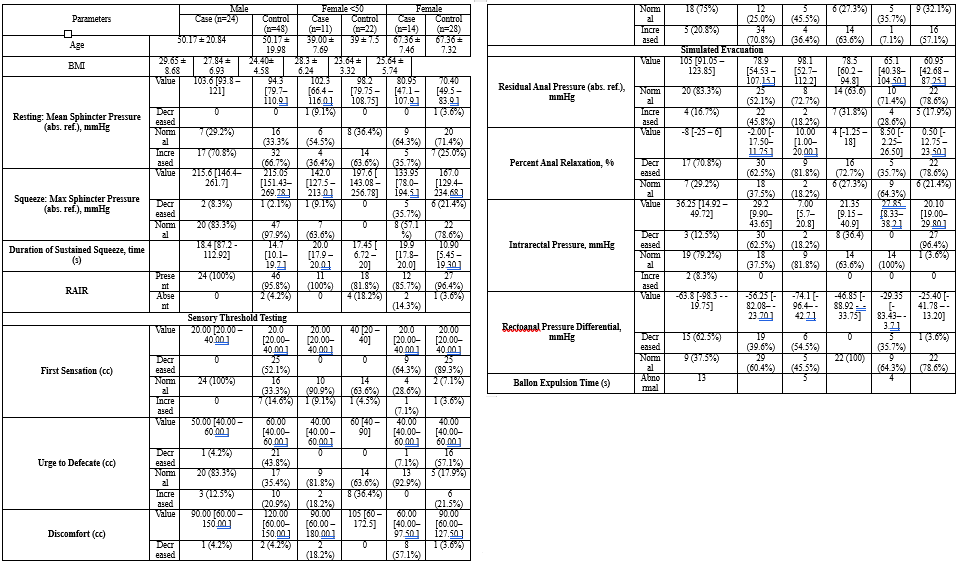Sunday Poster Session
Category: Colon
P0294 - Anorectal Manometry Parameter in Levator Ani Syndrome
Sunday, October 26, 2025
3:30 PM - 7:00 PM PDT
Location: Exhibit Hall
- RG
Riya Gupta, MBBS (she/her/hers)
Mayo Clinic
Phoenix, AZ
Presenting Author(s)
Riya Gupta, MBBS, Thomas Stievenard, , Nicholas Oblizajek, MD
Mayo Clinic, Rochester, MN
Introduction: Levator Ani Syndrome (LAS) is a functional anorectal disorder characterized by chronic anorectal pain, often without clear structural abnormalities. Differentiating LAS from functional constipation using anorectal manometry (ARM) remains challenging due to overlapping symptoms but potentially distinct physiologic features. We aimed to compare ARM findings in LAS versus constipation to identify distinguishing characteristics.
Methods: We conducted a retrospective case-control study of patients who underwent high-resolution ARM at Mayo Clinic Rochester between 2019 and 2024. Patients diagnosed with LAS were matched 1:2 by age and sex to those referred for constipation. A total of 49 LAS cases and 98 controls were included. ARM parameters analyzed included resting and squeeze pressures, rectoanal inhibitory reflex (RAIR), sensory thresholds, simulated evacuation metrics, intrarectal pressure, and rectoanal pressure differential.
Results: Among males, LAS patients had higher resting pressures (103.6 mmHg vs. 94.3 mmHg) and more frequent elevated resting tone. Intrarectal pressure was also higher (36.3 mmHg vs. 29.2 mmHg), with more negative rectoanal pressure differential. LAS males demonstrated more normal sensory thresholds, while constipation controls had higher rates of hyposensitivity. In females under 50, LAS cases showed lower squeeze pressures and shorter balloon expulsion times, with more normal sensory thresholds. Females over 50 with LAS had higher intrarectal pressures (27.9 mmHg vs. 20.1 mmHg), preserved rectal sensation, and greater anal resistance to evacuation. Across all groups, LAS patients exhibited higher anal tone, more impaired relaxation, and better preserved rectal sensation, while constipation controls often demonstrated rectal hyposensitivity and lower pressures.
Discussion: LAS and constipation have significant overlap in ARM parameter characteristics. Numerically, patients with LAS appear to have elevated anal sphincter tone as well as anal residual pressure with simulated evacuation as compared to controls. In addition, the rectoanal gradient appears to be abnormal more frequently in LAS patients as compared to this control cohort. By contrast, constipation patients more often exhibit rectal hyposensitivity. Further research is needed in gold standard diagnostic testing for LAS, which may inform future therapeutic strategies.

Figure: Levator ani syndrome vs Control Anorectal manometry results
Disclosures:
Riya Gupta indicated no relevant financial relationships.
Thomas Stievenard indicated no relevant financial relationships.
Nicholas Oblizajek indicated no relevant financial relationships.
Riya Gupta, MBBS, Thomas Stievenard, , Nicholas Oblizajek, MD. P0294 - Anorectal Manometry Parameter in Levator Ani Syndrome, ACG 2025 Annual Scientific Meeting Abstracts. Phoenix, AZ: American College of Gastroenterology.
Mayo Clinic, Rochester, MN
Introduction: Levator Ani Syndrome (LAS) is a functional anorectal disorder characterized by chronic anorectal pain, often without clear structural abnormalities. Differentiating LAS from functional constipation using anorectal manometry (ARM) remains challenging due to overlapping symptoms but potentially distinct physiologic features. We aimed to compare ARM findings in LAS versus constipation to identify distinguishing characteristics.
Methods: We conducted a retrospective case-control study of patients who underwent high-resolution ARM at Mayo Clinic Rochester between 2019 and 2024. Patients diagnosed with LAS were matched 1:2 by age and sex to those referred for constipation. A total of 49 LAS cases and 98 controls were included. ARM parameters analyzed included resting and squeeze pressures, rectoanal inhibitory reflex (RAIR), sensory thresholds, simulated evacuation metrics, intrarectal pressure, and rectoanal pressure differential.
Results: Among males, LAS patients had higher resting pressures (103.6 mmHg vs. 94.3 mmHg) and more frequent elevated resting tone. Intrarectal pressure was also higher (36.3 mmHg vs. 29.2 mmHg), with more negative rectoanal pressure differential. LAS males demonstrated more normal sensory thresholds, while constipation controls had higher rates of hyposensitivity. In females under 50, LAS cases showed lower squeeze pressures and shorter balloon expulsion times, with more normal sensory thresholds. Females over 50 with LAS had higher intrarectal pressures (27.9 mmHg vs. 20.1 mmHg), preserved rectal sensation, and greater anal resistance to evacuation. Across all groups, LAS patients exhibited higher anal tone, more impaired relaxation, and better preserved rectal sensation, while constipation controls often demonstrated rectal hyposensitivity and lower pressures.
Discussion: LAS and constipation have significant overlap in ARM parameter characteristics. Numerically, patients with LAS appear to have elevated anal sphincter tone as well as anal residual pressure with simulated evacuation as compared to controls. In addition, the rectoanal gradient appears to be abnormal more frequently in LAS patients as compared to this control cohort. By contrast, constipation patients more often exhibit rectal hyposensitivity. Further research is needed in gold standard diagnostic testing for LAS, which may inform future therapeutic strategies.

Figure: Levator ani syndrome vs Control Anorectal manometry results
Disclosures:
Riya Gupta indicated no relevant financial relationships.
Thomas Stievenard indicated no relevant financial relationships.
Nicholas Oblizajek indicated no relevant financial relationships.
Riya Gupta, MBBS, Thomas Stievenard, , Nicholas Oblizajek, MD. P0294 - Anorectal Manometry Parameter in Levator Ani Syndrome, ACG 2025 Annual Scientific Meeting Abstracts. Phoenix, AZ: American College of Gastroenterology.
